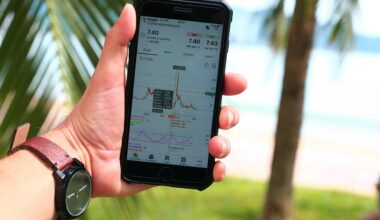How to Backtest Your Day Trading Strategies
Backtesting is a critical process in day trading that allows traders to evaluate their strategies based on historical data. It involves testing a trading strategy using past market data to determine its potential effectiveness before risking real capital. By simulating trades that would have occurred if the strategy were live, traders gain insights into profitability and risk. The goal is to find a strategy that has performed well historically and may continue to succeed in the future. It’s essential to analyze the results for metrics like win rate, risk-reward ratio, and maximum drawdown. Also, it’s important to adjust the strategy as necessary. This ensures that the strategy remains valid despite changing market conditions. Tools such as trading platforms with backtesting features can help automate this process. However, traders should remain cautious; backtesting does not guarantee future results and should not be the sole reliance for trading decisions. Comprehensive market understanding and ongoing adjustments are essential. Learning from both successful and unsuccessful trades is key to evolving a trader’s strategies and achieving long-term success.
When backtesting, one must first select a suitable trading strategy. Consider testing different strategies to identify which ones align best with personal risk tolerance and goals. A well-defined strategy should clearly outline entry and exit points, position sizing, and risk management rules. After defining the strategy, the next step is to gather historical data that accurately reflects the market environment in which you plan to trade. This data may vary based on asset class and trading style, so ensure it’s relevant. Quality data is crucial for reliable results. Traders often use software or trading platforms that provide historical data with comprehensive features for simplicity and efficiency. After data acquisition, simulate trades according to your strategy using this data. Record each trade’s outcome and analyze the effectiveness of your strategy comprehensively. Pay attention not only to profits but also to the proportion of winning trades, average gain per trade, and loss characteristics. Documenting the results is essential for ongoing assessment, allowing for strategy refinement and improvement over time.
Key Metrics to Analyze
Identifying key performance indicators (KPIs) during backtesting is vital for assessing a strategy’s effectiveness. Traders should focus on metrics like total return, maximum drawdown, and the Sharpe ratio. The total return indicates how much profit a strategy generated over a specified period. Meanwhile, maximum drawdown helps measure the potential risk by showing the maximum loss from a peak to a trough. Additionally, the Sharpe ratio adjusts returns for risk exposure, providing insight into how much return a trader is receiving per unit of risk taken. Understanding these metrics can clarify if the strategy is robust enough to withstand market fluctuations. Furthermore, tracking win-loss ratios can identify patterns that inform future trades. Analyzing the reasoning behind winning and losing trades allows traders to refine their strategies effectively. Backtesting results are not static; they should evolve alongside market changes. As traders continue to learn, ongoing assessment and adjustments are fundamental to maintaining a viable trading strategy over time, ensuring relevance and effectiveness as market dynamics fluctuate.
Another significant aspect of backtesting is recognizing overfitting, which can lead to misleading results. Overfitting occurs when a trading strategy is too finely tuned to past data, resulting in poor future performance. Creating a model that performs brilliantly on historical data but crumbles in real-time trading is a common mistake. To guard against overfitting, traders should utilize out-of-sample testing, wherein portions of data are reserved for testing a strategy’s performance outside of the initial dataset. Splitting the data into ‘in-sample’ data for developing the strategy and ‘out-of-sample’ data for testing can help validate findings. Furthermore, traders should limit the complexity of their strategies and ensure that risk management principles remain consistent throughout. Simplicity often results in more robust strategies which can adapt to changing market conditions. This versatility is critical in the ever-evolving financial landscape. As traders conduct thorough evaluations, learning to distinguish between suitable strategies and those vulnerable to overfitting will empower them to make more informed decisions.
Utilizing Automation Tools
Modern trading benefits significantly from automation tools that assist with backtesting. Several platforms offer built-in features for testing strategies, providing instant results without manual tracking. These tools help streamline analysis, making it easier for traders to review performance metrics effectively. Automation reduces human error, ensuring that all trades are executed according to the defined strategy without emotional interference. Popular software includes MetaTrader, TradeStation, and NinjaTrader, each offering diverse capabilities suitable for various trading styles. Users can customize parameters to fit their strategies, creating simulated trading environments that mimic real-world conditions accurately. Furthermore, many platforms provide the option to visualize data, enabling traders to interpret results intuitively. Clearly presenting data helps in understanding patterns and making structured decisions. However, while automation is beneficial, it should complement, not replace, traders’ analytical skills. Being actively engaged in the testing process promotes a deeper understanding of market behavior. This knowledge enhances adaptability in live trading, ultimately leading to more informed decisions and improved trading outcomes over time.
As backtesting concludes, it’s essential to transition smoothly into live trading. This next step requires careful preparation, as risks are inherent in real-time markets. Traders should start by implementing a small-scale version of their strategy to assess its viability under actual market conditions. This approach minimizes potential losses during the initial adaptation phase. Furthermore, maintaining emotional discipline is crucial for success in live markets. Understanding that live trading has different psychological challenges compared to backtesting is essential. Emotions can impact decision-making, leading to impulsive actions that deviate from the tested strategy. A solid discipline rooted in defined trading rules must guide all decisions. Continuous evaluation of trading performance through journaling can enhance learning and adaptation. By understanding mistakes and successes, traders become better equipped for future trades. Building a robust plan for handling emotions, risk management, and trade reviews will cultivate resilience and long-term profitability. Ultimately, successful day trading combines thorough preparedness through backtesting with effective tactics to maintain emotional and psychological balance in live environments.
The Journey Continues
Backtesting is not the end of a trading strategy’s journey but rather the beginning of a continuous improvement process. Market conditions are temporary and ever-changing, making regular strategy assessments necessary. As a trader gains experience, it is crucial to incorporate new knowledge and insights into existing strategies. Continuing education through books, workshops, and online courses is invaluable for ongoing development. Beyond theoretical knowledge, engaging with trading communities through forums and social media platforms offers diverse perspectives and valuable insights from fellow traders. Sharing and gaining diverse viewpoints contribute significantly to strategy refinement. Moreover, adapting to external factors such as geopolitical events and economic shifts aids in remaining proactive in the financial landscape. A trader must be flexible, adjusting strategies as needed while relying on their foundational principles. Modifying based on continuous market observation will support long-term growth and success. In summation, backtesting, when executed properly, empowers traders to build sound trading methodologies, refine their skills, and navigate the complexities of day trading toward achieving their financial aspirations.
In conclusion, mastering the art of backtesting is essential for aspiring day traders. The backtesting process offers invaluable insights into the potential effectiveness of trading strategies. By analyzing historical data, incorporating key performance indicators, and utilizing automation tools, traders can create strategies that cater to their unique goals while managing risks. It is crucial to remain vigilant against overfitting while ensuring that strategies evolve with changing market conditions. As traders transition to live trading, emotional discipline and ongoing evaluation become pivotal. Balancing the analytical approach developed during backtesting with real-time decision-making shapes the trader’s journey toward success. Additionally, the learning process never truly ends; ongoing education contributes to better adaptation and refinement. Building strong networks with fellow traders can enhance skillsets and perspectives. It’s the interplay of rigorous backtesting, emotional management, and continuous learning that shapes proficiency in day trading. Cultivating a comprehensive understanding of these components leads to better decision-making and improved performance. Traders must embrace their journeys, armed with the analytical skills acquired through backtesting combined with the adaptability necessary for the fast-paced trading world.


